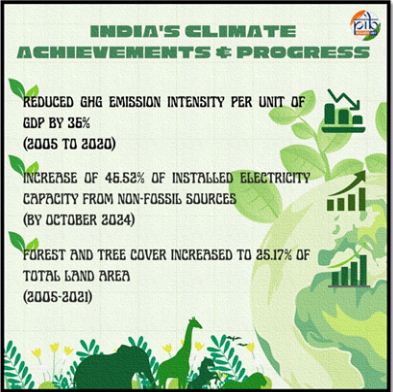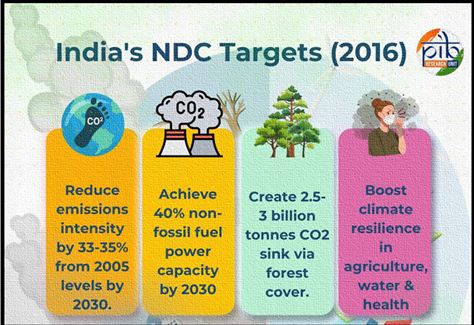January 13, 2025
India’s Climate Action Efforts and Commitments/ भारत की जलवायु कार्रवाई प्रयास और प्रतिबद्धताएँ:
Why in News? India submitted its 4th Biennial Update Report (BUR-4) to the UNFCCC on 30th December 2024.
India’s Climate Goals:
- Net-Zero Target: Achieve net-zero emissions by 2070 (announced at COP26 in 2021).
- Progress: India reported a 7.93% reduction in GHG emissions in 2020 compared to 2019 in its 4th Biennial Update Report (BUR-4).

Key Climate Action Frameworks:
UNFCCC Goals:
- Stabilize GHG concentrations.
- Limit global temperature rise to well below 2°C, aiming for 1.5°C.
India’s Long-Term Strategy (LT-LEDS):
- Focused on seven strategic transitions including low-carbon electricity, sustainable transport, urban adaptation, decoupling growth from emissions, CO2 removal, enhancing forest cover, and financial pathways.
Key Achievements and Facts:
- India’s Historical Emissions: Annual share only 4% of global cumulative emissions (1850-2019).
- Energy Consumption: Per capita primary energy consumption in 2019 was 28.7 GJ, significantly below global averages.
- Net Emissions (2020): Including Land Use, Land-Use Change, and Forestry (LULUCF): 2,437 million tonnes CO2e.
Major Initiatives:
Forest Conservation and Afforestation:
Compensatory Afforestation: For non-forest land use, including eco-restoration measures.
Green Credit Program (2023): Plantation on degraded lands for green credits.
National Afforestation Programme (NAP): Community-driven afforestation in degraded areas.

Urban Climate Adaptation:
- Integrating climate adaptation into urban planning (Smart Cities Mission, AMRUT, PMAY).
- Promoting energy and resource efficiency in urbanization.
Air Pollution Control:
- National Clean Air Programme (NCAP): City-specific action plans for 131 cities.
- Measures include cleaner fuels, ethanol blending, and BS-VI norms.
Coastal Ecosystem Conservation:
- MISHTI (2023): Mangrove restoration covering 540 km² in 9 states and 4 UTs.
- Integrated Coastal Zone Management Plans (ICZMP): Protection strategies for Gujarat, Odisha, and West Bengal.
Regulatory Measures:
- Coastal Regulation Zone (CRZ) Notifications: Focused on managing mangroves, coral reefs, and critical ecosystems (2011 & 2019).
Significant Programs and Policies:
- “Ek Ped Maa Ke Naam” Campaign: Nationwide tree plantation drive (2024).
- Funding Initiatives: Support through schemes like SBM (Urban), SATAT, and FAME-II for clean air and transportation.
India’s climate efforts reflect its commitment to equity, sustainability, and global cooperation under the Paris Agreement.
भारत की जलवायु कार्रवाई प्रयास और प्रतिबद्धताएँ:
चर्चा में क्यों ? भारत ने 30 दिसंबर 2024 को UNFCCC को अपनी चौथी द्विवार्षिक अद्यतन रिपोर्ट (BUR-4) प्रस्तुत की।
भारत के जलवायु लक्ष्य
- नेट-जीरो लक्ष्य: 2070 तक नेट-जीरो उत्सर्जन प्राप्त करना (COP26, 2021 में घोषित)।
- प्रगति: भारत ने 2020 में 2019 की तुलना में GHG उत्सर्जन में 7.93% की कमी दर्ज की (चौथी द्विवार्षिक अद्यतन रिपोर्ट – BUR-4)।
मुख्य जलवायु कार्रवाई ढांचे:
UNFCCC लक्ष्य:
- ग्रीनहाउस गैस (GHG) सांद्रता को स्थिर करना।
- वैश्विक तापमान वृद्धि को पूर्व-औद्योगिक स्तरों से 2°C से नीचे, और 1.5°C तक सीमित करने का प्रयास।
भारत की दीर्घकालिक रणनीति (LT-LEDS):
सात रणनीतिक बदलावों पर केंद्रित, जैसे:
- कम-कार्बन बिजली प्रणाली,
- सतत परिवहन,
- शहरी अनुकूलन,
- उत्सर्जन से अलग विकास,
- CO2 हटाने,
- वनों का संरक्षण और वित्तीय मार्ग।
प्रमुख उपलब्धियाँ और तथ्य:
- भारत का ऐतिहासिक उत्सर्जन: 1850-2019 के बीच वैश्विक संचयी उत्सर्जन का केवल 4% हिस्सा।
- ऊर्जा खपत: 2019 में प्रति व्यक्ति प्राथमिक ऊर्जा खपत 28.7 गीगाजूल (GJ), वैश्विक औसत से काफी कम।
- शुद्ध उत्सर्जन (2020): भूमि उपयोग परिवर्तन और वानिकी (LULUCF) सहित 2,437 मिलियन टन CO2e।
मुख्य पहलें:
वन संरक्षण और वनीकरण:
क्षतिपूरक वनीकरण: गैर-वन भूमि उपयोग के लिए, जिसमें पारिस्थितिकी पुनर्स्थापन उपाय शामिल हैं।
ग्रीन क्रेडिट कार्यक्रम (2023): वनों के पुनर्स्थापन हेतु।
राष्ट्रीय वनीकरण कार्यक्रम (NAP): सामुदायिक भागीदारी से वनीकरण।
शहरी जलवायु अनुकूलन:
- स्मार्ट सिटी मिशन, AMRUT, PMAY के माध्यम से शहरी नियोजन में जलवायु अनुकूलन का एकीकरण।
- ऊर्जा और संसाधन दक्षता को बढ़ावा।
वायु प्रदूषण नियंत्रण:
- राष्ट्रीय स्वच्छ वायु कार्यक्रम (NCAP): 131 शहरों के लिए शहर-विशिष्ट कार्य योजनाएँ।
- स्वच्छ ईंधन, एथेनॉल मिश्रण, और BS-VI मानकों को लागू करना।
तटीय पारिस्थितिकी तंत्र संरक्षण:
MISHTI (2023): 9 राज्यों और 4 केंद्रशासित प्रदेशों में 540 किमी² में मैंग्रोव पुनर्स्थापन।
ICZMP योजनाएँ: गुजरात, ओडिशा और पश्चिम बंगाल के लिए संरक्षण रणनीतियाँ।
नियामक उपाय:
- तटीय विनियमन क्षेत्र (CRZ) अधिसूचनाएँ: मैंग्रोव, मूंगा चट्टान और महत्वपूर्ण पारिस्थितिक तंत्र का प्रबंधन।
महत्वपूर्ण कार्यक्रम और नीतियाँ
- “एक पेड़ माँ के नाम” अभियान: विश्व पर्यावरण दिवस (2024) पर राष्ट्रव्यापी वृक्षारोपण अभियान।
- वित्त पोषण पहल: स्वच्छ वायु और परिवहन के लिए SBM (Urban), SATAT, और FAME-II जैसी योजनाओं के माध्यम से समर्थन।
January 30, 2025
January 20, 2025
January 14, 2025
